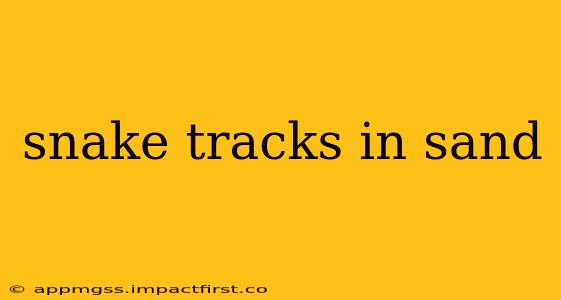Snake tracks in sand offer a fascinating glimpse into the secret lives of these often elusive creatures. Identifying these tracks can be challenging, but with a little knowledge and observation, you can learn to distinguish between different species and even glean insights into their behavior. This guide will delve into the world of snake tracks, helping you understand what to look for and how to interpret the clues they leave behind.
What do snake tracks in the sand look like?
Snake tracks are typically characterized by a series of paired impressions, representing the scales on the snake's belly. Unlike the distinct paw prints of mammals, snake tracks are less defined and can vary depending on the snake's size, species, and the type of sand. The tracks often appear as a series of shallow, parallel grooves or lines, sometimes with a slightly raised central ridge. The distance between the pairs of impressions will vary, reflecting the snake's gait and body size. Larger snakes will leave wider, more distinct tracks, while smaller snakes leave subtler markings. The depth of the tracks also depends on the moisture content of the sand; wetter sand will hold deeper impressions.
How can I tell the difference between snake tracks and other animal tracks?
This is a crucial question, as many other animals can leave tracks that might be confused with those of snakes. Lizards, for instance, might leave similar paired impressions, but often with more distinct claw marks. Birds, insects, and even small mammals can leave tracks that may seem similar at first glance. The key is to look for the subtle differences: the lack of claw marks, the paired nature of the impressions, and the consistent spacing between them are telltale signs of a snake. Examining the overall pattern and shape of the trail also helps; snake tracks generally follow a relatively smooth, winding path, unlike the more erratic movements of many other creatures.
How to identify different snake species from their tracks?
Unfortunately, definitively identifying a specific snake species solely from its tracks is generally not possible. The subtle variations in track size and pattern are often insufficient for accurate species identification. Factors such as the sand's consistency and the snake's speed will all influence the track's appearance. However, the size of the track can provide a general indication of the snake's size, helping you narrow down the possibilities based on the known snakes inhabiting the area.
What can snake tracks tell me about the snake's behavior?
While exact species identification may be difficult, observing snake tracks can reveal valuable behavioral information. The direction of the tracks can indicate the snake's movement patterns and potential hunting grounds. The density and frequency of tracks in a certain area could suggest the presence of a larger population or a preferred habitat. A sudden change in direction might indicate a reaction to a stimulus, such as encountering prey or a predator. Analyzing the trail as a whole, rather than just individual tracks, provides a more holistic understanding of the snake's movements and activities.
Can snake tracks help me avoid dangerous snakes?
While observing snake tracks won't directly prevent encounters, they can offer an indication of snake presence in an area. If you encounter numerous tracks in a particular location, it is wise to exercise caution and be more vigilant in your surroundings. Knowing the potential types of snakes in the region will further aid your safety precautions. Remember, avoiding contact is always the best way to ensure safety.
Are there any resources to help me learn more about identifying snake tracks?
Several herpetology books and field guides provide detailed information on snake identification, including descriptions of tracks. Additionally, online resources like websites dedicated to wildlife tracking and herpetological societies offer valuable information and images for comparison. Local natural history museums and conservation organizations can also be valuable resources for learning about the snakes in your region and identifying their tracks.
By carefully observing and analyzing snake tracks, you can gain valuable insights into the often-hidden world of snakes. While complete identification might be challenging, understanding the general characteristics of snake tracks and interpreting their patterns can contribute significantly to appreciating the natural world around us. Remember always to respect wildlife and maintain a safe distance when observing animals in their natural habitat.
